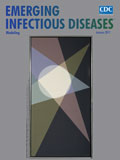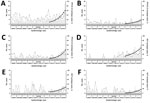
Volume 23, Number 1—January 2017
Dispatch
Increased Invasive Pneumococcal Disease, North East England, UK
On This Page
Abstract
Since April 2014, invasive pneumococcal disease incidence has increased substantially across North East England, United Kingdom, reversing the decline that followed the 2006 introduction of pneumococcal conjugate vaccines. Significant increases occurred in 23-valent polysaccharide vaccine serotypes and nonvaccine serotypes. Trends in other regions and long-term effects of multivalent vaccines require further investigation.
The UK routine immunization program includes 2 vaccines against pneumococcal disease (1). The 7-valent pneumococcal conjugate vaccine (PCV7), introduced in 2006 and replaced by the 13-valent pneumococcal conjugate vaccine (PCV13) in 2010, is given to infants 2, 4, and 12 months of age (1). The 23-valent pneumococcal polysaccharide vaccine (PPV23) has been recommended for persons in clinically defined risk groups >2 years of age since 1992 and for all persons >65 years of age since 2003 (1). National coverage of PCV at 12 months reached 90% by epidemiologic year (April 1–March 31, indicated by slashes in year ranges) 2008/2009 and remains >93% (2). Since 2009/2010, coverage in North East England (NEE) has been >95% (2). By 2007/2008, PPV coverage in England and NEE reached 70% among all persons >65 years of age and remained there through March 31, 2016 (3).
Invasive pneumococcal disease (IPD) incidence in NEE declined significantly after the introduction of PCV7 and subsequently PCV13 among persons in vaccinated and nonvaccinated age groups, consistent with other countries and the United Kingdom (4–8). This decline coincided with emergence of less frequent nonvaccine type (NVT) serotypes, reinforcing the need for continued IPD surveillance (4–8). Using enhanced surveillance data for April 1, 2006, through March 31, 2016, we detected increased IPD incidence in NEE.
In April 2006, the NEE Invasive Pneumococcal Disease Enhanced Surveillance System was established (4) and gathered data from microbiology services, hospitals and primary care clinicians, and the Public Health England Respiratory and Vaccine Preventable Bacteria Reference Unit (9). We compared IPD incidence during the 2015/2016 epidemiologic year with that from previous epidemiologic years and with the average annual incidence during the 3 epidemiologic years covering April 1, 2011–March 31, 2014. We analyzed IPD incidence across all cases combined and cases stratified by vaccine serotype subgroups: PCV7/PCV13 serotypes (1, 3, 4, 5, 6A, 6B, 7F, 9V, 14, 18C, 19A, 19F, 23F); PPV23-exclusive serotypes (2, 8, 9N, 10A, 11A, 12F, 15B [including 15B/C], 17F, 20, 22F, 33F); and NVT serotypes (1). We examined IPD incidence trends by specific serotype during April 2013–March 2016 by using incidence rate ratios (IRRs), estimated by using negative binomial regression (with counts per calendar quarter, robust standard errors, and offset with the natural logarithm of the NEE population [10]).
For each epidemiologic year spanning April 1, 2011–March 31, 2014, an average of 211 IPD cases (8.1 cases/100,000 population) were reported. In contrast, during 2015/2016, a total of 298 cases (11.4/100,000) were reported. This incidence was significantly greater than that for 2014/2015 (230 cases, 8.8/100,000; IRR 1.30, 95% CI 1.09–1.55, p = 0.003); significantly greater than the average during the 3 epidemiologic years spanning 2011–2014 (IRR 1.40, 95% CI 1.17–1.68, p<0 .001="" 0.81="" 0.96="" 2006="" 95="" a="" and="" ci="" class="tp-link-policy" href="https://wwwnc.cdc.gov/eid/article/23/1/16-0897-t1" irr="" p="0.577)" similar="" style="color: #075290;" title="Table 1" to="">Table 1

Figure 1. Number and incidence (no. cases/100,000 population) of invasive pneumococcal disease cases by vaccine type serotype subgroups in North East England, by quarter April 2006–March 2016. A) All cases. B) Cases caused...

Figure 2. Trends in incidence of serotypes causing invasive pneumococcal disease associated with recent significantly increasing incidence in North East England, by quarter, April 2006–March 2016. Panels show trends by individual serotypes: A)...
The recent rise in IPD is largely attributable to increased cases caused by PPV23-exclusive serotypes (2015/2016 vs. 2011–2014 IRR 2.42, 95% CI 1.80–3.29, p<0 .001="" 2.20="" 2006="" 2014="" 2015="" 3.04="" 95="" a="" ci="" class="tp-link-policy" from="" href="https://wwwnc.cdc.gov/eid/article/23/1/16-0897_article#tnF1" irr="" notable="" on="" p="" style="color: #075290;" title="Figure 1" vs.="">Figure 1
). Of the 11 serotypes exclusive to PPV23, significant increasing trends were demonstrated by serotypes 8, 9N, and 12F from 2013/2014 on (Table 2; Figure 2). This trend was observed among patients 5–64 and >65 years of age; cases among patients <5 age="" and="" by="" changes="" considerably="" data="" difficult="" fewer="" interpret="" not="" of="" p="" serotype="" shown="" temporal="" to="" were="" years="">
Over the longer term, the number of cases caused by NVT serotypes increased between 2006/2007 and 2015/2016 (IRR 2.58, 95% CI 1.52–4.56, p<0 .001="" 2008="" a="" class="tp-link-policy" from="" href="https://wwwnc.cdc.gov/eid/article/23/1/16-0897_article#tnF1" on="" particularly="" style="color: #075290;" title="Figure 1">Figure 1
). The increased incidence of IPD caused by NVT was not statistically significant between 2015/2016 and 2011–2014 (IRR 1.23, 95% CI 0.80–1.88, p = 0.236). Among NVTs with an observed increase, serotypes 15A, 23A, and 35F increased significantly from 2013/2014 on (Table 2; Figure 2). For 23A, this increase was particularly notable among persons >65 years of age; for serotypes 15A and 35F, the increase was among persons 5–64 and >65 years of age (data not shown).
Total IPD incidence increased significantly, starting in 2014/2015, reversing the declines in total IPD incidence that followed the introduction of PCVs (4–8). The increases were significant for PPV23-exclusive serotypes 8, 9N, and 12F and for NVT serotypes 15A, 23A, and 35F, most notably among persons 5–64 and >65 years of age.
We know of no mechanism for increased host susceptibility that could explain these rapid incidence changes. Although associations between influenza and IPD have been reported (11,12) and genetically drifted influenza strains contributed to low vaccine effectiveness in the United Kingdom during 2014/2015 (13), our primary analysis compared 2015/2016 with 2011–2014 so that any IPD increase associated with the 2014–2015 influenza season had no influence on these findings.
Mechanisms for changes in serotype prevalence include serotype replacement and capsular switching (genetic serotype switch in individual organisms) (14). In NEE, serotype replacement and declining IPD incidence were observed among persons of all age groups soon after introduction of PCV7 childhood vaccination (4), highlighting the influence of strains affecting young children in determining prevalent pneumococcal serotypes among persons in nonvaccine age groups. With ongoing >95% vaccination coverage in NEE, direct protection extends into an ever-increasing proportion of the population, up to those 10 years of age in 2016, increasing pressure on PCV strains. This pressure may be leading to accelerated serotype replacement throughout the population or to increased capsular switching, resulting in some non-PCV serotypes becoming more prevalent. Natural fluctuations in serotype prevalence may also be occurring. However, explanations for the recent IPD increase need to account for the recent and somewhat sudden rise following a long period of decline. For instance, perhaps natural expansion of non-PCV strains into the ecologic niches created has been delayed and therefore the decline observed was only temporary, or perhaps there have been recent changes in invasiveness of the non-PCV strains either naturally or associated with serotype replacement or capsular switching.
Our findings, together with data from all England (15), suggest that IPD epidemiology continues to evolve after 10 years of routine childhood vaccination. Observations from other regions that have introduced PCV are merited to determine whether the increase observed in NEE is, or becomes, a widespread phenomenon and, if so, its relationship to the timing of PCV implementation and PCV coverage. Also needed are further studies of the effects of ongoing vaccination on carriage and molecular studies to identify evidence for capsular switching and changes in invasiveness. Clarification of such factors may help guide changes to public health strategies required to tackle persistent IPD.
Dr. Houseman is a research fellow in the North East Field Epidemiology Team, Public Health England, UK. Her research interests are epidemiology and infectious diseases, including IPD.
Acknowledgments
We thank the Public Health England North East Health Protection Team for their participation in IPD enhanced surveillance, the Public Health England Respiratory and Vaccine Preventable Bacteria Reference Unit for providing serotype results, all North East National Health Service microbiology laboratories for reporting cases of IPD, and teams from primary care and acute National Health Service trusts across NEE for providing enhanced surveillance data.
This work was supported by a grant from the Health Protection Agency Strategic Research and Development Fund, April 2009–March 2012; an unrestricted educational grant from Sanofi Pasteur MSD (UK12C1036), April 2012–June 2014; and an unrestricted grant from Pfizer UK Ltd (WI194024), August 2015. The funders had no role in the study design, data collection and analysis, or manuscript preparation.
References
- Department of Health. Immunisation against infectious disease. The Green Book. 2012;25:295–313 [cited 2016 May 31]. https://www.gov.uk/government/uploads/system/uploads/attachment_data/file/147832/Green-Book-updated-140313.pdf
- Health & Social Care Information Centre. NHS Immunisation Statistics, England: 2014–2015 [cited 2016 Jul 19]. http://www.hscic.gov.uk/catalogue/PUB18472
- Public Health England. Pneumococcal polysaccharide vaccine (PPV): vaccine coverage estimates [cited 2016 Jul 19]. https://www.gov.uk/government/publications/pneumococcal-polysaccharide-vaccine-ppv-vaccine-coverage-estimates
- Chapman KE, Wilson D, Gorton R. Serotype dynamics of invasive pneumococcal disease post-PCV7 and pre-PCV13 introduction in North East England. Epidemiol Infect. 2013;141:344–52. DOIPubMed
- Waight PA, Andrews NJ, Ladhani SN, Sheppard CL, Slack MP, Miller E. Effect of the 13-valent pneumococcal conjugate vaccine on invasive pneumococcal disease in England and Wales 4 years after its introduction: an observational cohort study. Lancet Infect Dis. 2015;15:535–43. DOIPubMed
- Galanis I, Lindstrand A, Darenberg J, Browall S, Nannapaneni P, Sjöström K, et al. Effects of PCV7 and PCV13 on invasive pneumococcal disease and carriage in Stockholm, Sweden. Eur Respir J. 2016;47:1208–18. DOIPubMed
- Moore MR, Link-Gelles R, Schaffner W, Lynfield R, Lexau C, Bennett NM, et al. Effect of use of 13-valent pneumococcal conjugate vaccine in children on invasive pneumococcal disease in children and adults in the USA: analysis of multisite, population-based surveillance. Lancet Infect Dis. 2015;15:301–9. DOIPubMed
- De Wals P, Lefebvre B, Markowski F, Deceuninck G, Defay F, Douville-Fradet M, et al. Impact of 2+1 pneumococcal conjugate vaccine program in the province of Quebec, Canada. Vaccine. 2014;32:1501–6. DOIPubMed
- Hughes GJ, Wright LB, Chapman KE, Wilson D, Gorton R. Serotype-specific differences in short- and longer-term mortality following invasive pneumococcal disease. Epidemiol Infect. 2016;144:2654–69. https://doi.org/10.1017/S0950268816000856PubMed
- Office for National Statistics. Annual mid-year population estimates: 2014 [cited 2015 May 3]. https://www.ons.gov.uk/peoplepopulationandcommunity/populationandmigration/populationestimates/bulletins/annualmidyearpopulationestimates/2015-06-25
- Kuster SP, Tuite AR, Kwong JC, McGeer A, Fisman DN; Toronto Invasive Bacterial Diseases Network Investigators. Evaluation of coseasonality of influenza and invasive pneumococcal disease: results from prospective surveillance. PLoS Med. 2011;8:e1001042. DOIPubMed
- McCullers JA, McAuley JL, Browall S, Iverson AR, Boyd KL, Henriques Normark B. Influenza enhances susceptibility to natural acquisition of and disease due to Streptococcus pneumoniae in ferrets. J Infect Dis. 2010;202:1287–95. DOIPubMed
- Pebody R, Warburton F, Andrews N, Ellis J, von Wissmann B, Robertson C, et al. Effectiveness of seasonal influenza vaccine in preventing laboratory-confirmed influenza in primary care in the United Kingdom: 2014/15 end of season results. Euro Surveill. 2015;20:30013. DOIPubMed
- Wyres KL, Lambertsen LM, Croucher NJ, McGee L, von Gottberg A, Liñares J, et al. Pneumococcal capsular switching: a historical perspective. J Infect Dis. 2013;207:439–49. DOIPubMed
- Public Health England. Pneumococcal disease: guidance, data and analysis [cited 2016 May 31] https://www.gov.uk/government/collections/pneumococcal-disease-guidance-data-and-analysis
Figures
Tables
Cite This Article
1These authors were co-principal investigators.





















.jpg)












No hay comentarios:
Publicar un comentario